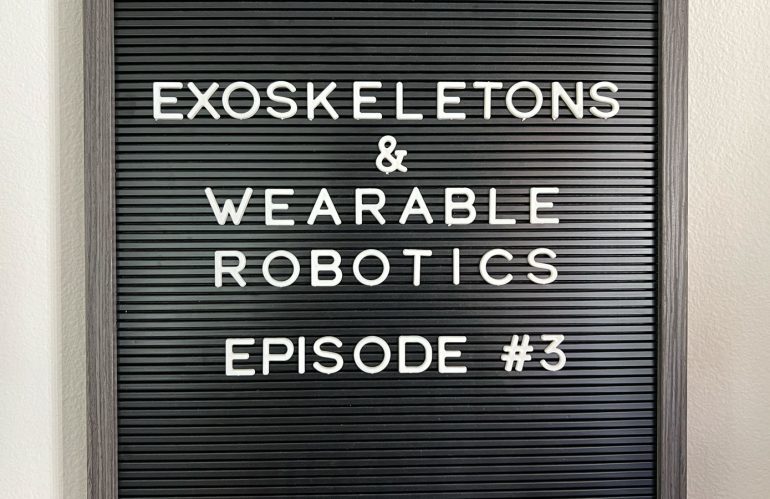The joint video series between the Wearable Robotics Association and the Exoskeleton Report is starting to transform into a full podcast. In this episode, we explore the applications of industrial and occupational exoskeletons. What can they do for you? How can wearable robotics change how we do repetitive work?
If you know people who have ever worked professionally in construction, you have probably heard of career-threatening injuries to them or their coworkers. While humanity has gone through a digital revolution and we have changed how we communicate with one another, physically intensive and “dirty” work is still done the same way, taking a toll on the bodies of billions around the world.
The article below was originally published on the Exoskeleton Report.
Major Topics:
- Industrial/Occupational Exoskeletons: Specific categories, including arm and shoulder support, back support, leg support, power gloves, and tool-holding exoskeletons.
- Arm and Shoulder Support Exoskeletons: Passive and powered exoskeletons are used to reduce fatigue and prevent shoulder injuries.
- Back Support Exoskeletons: Devices designed to support the lower back, particularly for repetitive tasks like lifting in logistics and warehouses.
- Leg Support Exoskeletons and Chairless Chairs: Solutions for squatting, kneeling, and working in positions where traditional chairs are not allowed, and their use in industrial and medical applications.
- Tool-Holding Exoskeletons: Systems that transfer the weight of heavy tools like grinders and welders to reduce fatigue.
- Power Gloves: Devices that enhance grip strength and reduce fatigue for long-duration tasks requiring sustained hand use.
- Geographical Use: Discussion of where exoskeletons are being implemented (e.g., Western Europe, Japan, Korea, and North America).
- Future Topics: Considerations for future episodes, such as matching exoskeletons to specific tasks and customization.
Summary (generated by AI):
In this episode, Bobby Marinov from Exoskeleton Report and Dr. Tom Sugar from the Wearable Robotics Association discuss the applications of industrial and occupational exoskeletons, focusing on arm and shoulder support, back support, leg support, power gloves, and tool-holding exoskeletons. They begin by distinguishing industrial exoskeletons from other categories, such as medical and military, explaining that these devices are primarily used to reduce fatigue and prevent injuries in industries like manufacturing and logistics. They emphasize the growing number of exoskeletons available, with over 100 occupational devices identified by the Exoskeleton Report, each designed to address specific worker needs.
The conversation dives into arm and shoulder support exoskeletons, starting with passive devices that use springs or elastic elements to support workers in tasks that require holding their arms above their heads, such as welding or painting. While these devices effectively reduce fatigue during repetitive overhead tasks, Tom and Bobby acknowledge some limitations, like the potential for users to feel resistance when lowering their arms. They also touch on powered exoskeletons, which provide more dynamic support by using motors or pneumatic systems to assist with tasks when needed and turn off when not in use, potentially offering a more seamless experience for workers. They emphasize, however, that at this time, one approach is not necessarily better than the other; it is just different.
Bobby and Tom then move on to back support exoskeletons, highlighting their role in alleviating strain during repetitive lifting tasks in logistics and warehouse environments. They discuss both passive and powered systems, explaining how they redistribute forces to reduce the risk of injury. Bobby shares a personal story about using a back exoskeleton for dishwashing, illustrating how these devices can make a noticeable difference in everyday activities. The two also discuss leg support systems, particularly chairless chairs, which allow workers to alternate between standing and sitting without the need for traditional seating, making them valuable in industries like construction and surgery.
The final part of the discussion focuses on tool-holding exoskeletons, which help workers manage heavy tools by transferring the weight to the ground, and power gloves, designed to enhance grip strength and reduce hand fatigue during prolonged tasks. They wrap up by reflecting on the global adoption of these technologies, particularly in Europe and Asia, and note that the U.S. is beginning to catch up. Bobby and Tom agree that exoskeletons are proving themselves as effective ergonomic solutions when properly matched to the task, hinting at future discussions on customization, evaluation, and the challenges of integrating these devices into various work environments.
Please note that the views and opinions expressed in this podcast are solely those of the hosts and do not necessarily reflect the official positions or policies of any companies, organizations, or agencies we may be associated with.
